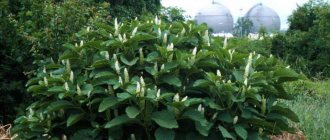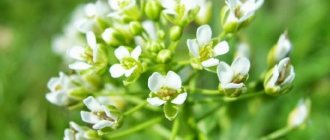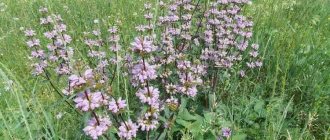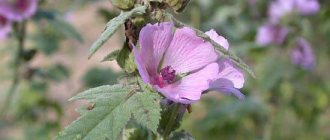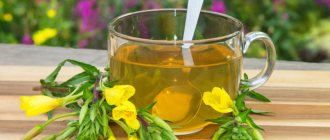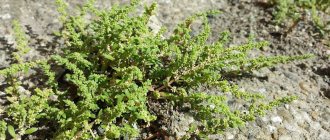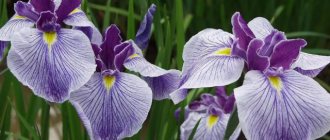Baikal skullcap is a popular plant in folk medicine, famous for a number of healing properties. The grass is often popularly called scale insects, the rejuvenating flower of the East, queen plant, babka, shark, forget-me-nots, and Chernobyl.
The medicinal qualities of the plant are not recognized by official medicine, which does not prevent the active use of herbal decoctions and tinctures in home treatment - products rich in useful substances are considered a worthy alternative to medications.
Brief description, growth of Baikal skullcap
Baikal skullcap is a perennial herbaceous plant belonging to the large Lamiaceae family. The grass has a low stem (up to 35 cm), covered with short, hard hair, opposite, short-petioled leaves, and a long, powerful rhizome. The length of the roots often reaches half a meter. The rhizome usually develops deep into the soil in search of moisture and useful elements.
The flowers are large and purple in color. They are collected in small inflorescences - one-sided brushes. Flowering begins in June, lasts up to two months, and ends with the formation of fruits - black nuts covered with fine hair. When touched, the seed pods shoot out tiny seeds.
Baikal skullcap usually grows in the Far East, Transbaikalia, and Siberia. Rare, but found in the Amur region and Buryatia. It prefers poor soils - it grows wildly on sandstones and rocky slopes. You can also find thickets of scale insects near bodies of water (on the banks of rivers and lakes).
Baikal skullcap - a remedy for all diseases
Baikal skullcap has long been used in traditional medicine to treat various diseases, and Chinese traditional medicine considers this plant a cure for all diseases. Over the last decade, it has attracted the attention of scientists around the world for its unique flavone group compounds contained in its roots. These are the flavones baicalin and wogonin. Research by UK scientists from the John Innes Center has confirmed that these flavones can neutralize cancer cells and liver diseases. Moreover, they act selectively, destroying only tumor cells, leaving healthy cells of the body untouched.
Baikalin and vogonin differ from all known flavones in the absence of a hydroxyl group, which puzzles scientists a lot. It has already been discovered that in the synthesis of these skullcap flavones, it is not the usual substance naringenin that takes part, but chrysin, which is devoid of a hydroxyl group, which is characterized by the property of restoring hormonal balance and antitumor properties.
If scientists completely unravel the mystery of the biochemical pathway for the synthesis of these flavones in the roots of the plant, this will make it possible to obtain baicalin and wogonin chemically in quantities that will be sufficient to create drugs effective in the fight against liver cancer. Today in the article:
- Botanical description of Baikal skullcap.
- What chemical elements are included in its composition?
- Baikal skullcap root. Preparation and storage.
- Medicinal properties of skullcap Baikal.
- What ailments does Baikal skullcap treat?
- Use of skullcap in Eastern medicine.
- Methods of using Baikal skullcap.
- Side effects of skullcap Baikal and contraindications.
- Popular types of skullcap.
- Where to buy Baikal skullcap?
Botanical description of Baikal skullcap.
Baikal skullcap (Scutellaria baicalensis Georgi), one of the representatives of a huge genus of skullcaps, numbering about 460 species, but it is one of the few and almost the only representative that has medicinal properties, and quite extraordinary ones.
People call it differently: mother plant, blue St. John's wort, helmet, heart grass, shield and scale insect, shark...
It grows wild throughout the steppe zone of Transbaikalia, the Amur Region, and the Primorsky Territory. It can be found in sunny areas and on forest edges, on the slopes of hills, and along river banks. Its distribution area is considered to be Eastern Siberia; the plant is found in China and Mongolia.
But in the Far East and Ukraine it is cultivated, this is caused by a decrease in stocks of skullcap; it takes root easily and is not particularly demanding of care, but loves sandy and rocky soil.
At our dacha, skullcap is like a weed, appearing here and there. We have a bed with wild herbs, where I transplant medicinal plants brought from the forest and steppe, and from the edge of this bed the Baikal skullcap itself grew, it is still young, when it grows, it will be beautiful.
This is a perennial plant, in favorable conditions it grows up to 35 cm in height, with a branched stem and many one-sided racemes in which blue flowers are collected. The flowers have a two-lipped shape (the upper lip is like a helmet, and the lower one is flat) up to 2-3 cm. The leaves are oblong, hard, located oppositely on the stem, without petioles. The root is thick and short, up to 50 cm; in young plants it is yellow at the break, in old plants it is brown.
Scutellaria blooms in June-July, at the end of flowering it forms a fruit - a nut.
What chemical elements are included in its composition?
Traditional medicine uses all parts of the plant for treatment, but the most valuable are the roots of skullcap.
More than a hundred different flavonoids, unique in their effects, have been found in the components of the rhizome; only a quarter of this number has been studied by scientists. Particularly unique is baicalin, which is not found in any other plant, only in the Baikal skullcap. This substance has a positive effect on blood vessels, dilating them, and also has an anticonvulsant effect, antitumor (therefore it is used in the treatment of oncology) and anti-infective properties.
The flavone scutellarein helps cleanse the body of waste and toxins.
Coumarins and pyrocatechins have antitumor effects; the roots contain micro and macroelements (potassium and calcium, magnesium and iron, zinc, copper, manganese, cobalt, iodine, molybdenum), steroids and saponins, resins and tannins, essential oils and starch.
The entire composition of biologically active substances, macro and microelements, complementing each other, provides high healing ability to Baikal skullcap.
Baikal skullcap root. Preparation and storage.
Biologically active substances and flavonoids are found in all parts of the plant, but the root of the Baikal skullcap is more often used for medicinal purposes. Traditional medicine recommends harvesting plant roots only after 3 years of age; younger roots cannot be harvested.
Taking into account that the plant can regain its strength, it should be returned to the place where roots were harvested only after 10 years.
The roots are harvested at the end of summer, when the growing season of the plant ends and it is at the seed ripening stage. After digging up the roots, they are well cleared of soil, washed with water and dried in a well-ventilated room protected from sunlight. Industrial dryers are also used for drying. Dryers should be set to a temperature no higher than 40 degrees.
Store dry roots in fabric bags or wooden boxes; the room for storing roots should be dry and ventilated. The root of Baikal skullcap retains its medicinal properties for up to 3 years.
Medicinal properties of skullcap Baikal.
It is interesting that the first mention of treatment with Baikal skullcap, and this has been scientifically proven, dates back to the First century BC. Since then, ancient healing recipes based on the root of the plant have come down to the present day, which were used to treat heart disease and fever.
Nowadays, research on skullcap continues, since it has not been fully studied, and this plant each time discovers its new medicinal properties, it is no coincidence that it is called a cure for all diseases.
☀ Baikal skullcap has antitumor and antioxidant activity. Decoctions and tinctures of the root are used to prevent cancer, as well as slow down the formation of metastases in cancer, it helps strengthen the body's immune system.
☀ This plant has antibacterial, antiviral and antipyretic medicinal properties, so it is used to treat colds, it is recommended to use it during the postoperative period to prevent inflammation and increase the vitality of the body.
☀ The sedative property of skullcap allows it to be used by people with increased excitability of the nervous system, insomnia and stressful situations. Traditional medicine of Transbaikalia believes that skullcap is stronger in its calming properties than medicinal valerian.
☀ Adaptogenic substances have been found in skullcap, so in our region it is also used as a means to help restore the nervous system in extreme conditions, to increase performance and concentration, relieve stress and improve overall well-being.
☀ Vasodilating properties help lower blood pressure and relieve vascular spasms.
☀ The anticonvulsant effect of skullcap is used in folk medicine to relieve muscle spasms and is used to treat seizures.
☀ Antitoxic healing property is used for food and other types of poisoning.
☀ Skullcap is used as a hemostatic agent for internal and external bleeding and wound healing.
☀ Diuretic, choleretic and laxative properties. Plant preparations are used to cleanse the kidneys, remove excess fluid from the body, and relieve swelling. The choleretic properties of the plant are used for asthma, allergic reactions, and sclerosis.
☀ In addition to all of the above, it has:
- anti-inflammatory and antipyretic,
- antiallergic and hypotensive,
- soothing and immunostimulating,
- antihelminthic and antifungal properties.
What ailments does Baikal skullcap treat?
The scientific world has long recognized the universality of the medicinal properties of Baikal skullcap; it is used for almost all diseases.
☀ Most often, its decoctions, tinctures and infusions are used to treat cardiovascular diseases; it is valued for its ability to normalize the rhythm of heart contractions, dilate blood vessels, eliminate insomnia and migraines. And it is also famous as a plant that copes with oncology. To better understand the versatility of this plant’s effects on diseases, look at what Baikal skullcap treats:
☀ It has been established that vagonin and baycolin have antitumor properties; they inhibit the formation of metastases. These properties of Scutellaria baicalensis have been successfully used by traditional Chinese medicine to treat prostate, kidney, liver cancer, leukemia and lymphosarcoma.
☀ Traditional medicine uses skullcap for the treatment of neuroma, neuroblastoma, lymphosarcoma and lymphogranulomatosis, as an adjuvant.
☀ The plant is an effective natural remedy for cardiovascular diseases. Thanks to its active substances, skullcap preparations act to restore vascular tone and normalize blood pressure, and reduce the level of bad cholesterol. It is recommended for use as a prophylactic agent for myocardial infarction, for the treatment of hypertension, tachycardia, myocarditis, vascular sclerosis, and cardiovascular neuroses.
☀ It also has a positive effect on diseases of the gastrointestinal tract. The plant is used to improve appetite, as a choleretic and laxative. For the treatment of liver diseases (gastroenteritis, hepatitis, liver cancer), heaviness in the stomach, nausea, intestinal weakness.
☀ Studies have shown that baicalin increases the body's resistance to infectious diseases and has a diuretic effect. It is used for diseases of the genitourinary system; it is no coincidence that one of the local names for skullcap is queenwort.
☀ Everyone knows the hemostatic properties of skullcap, which are used to treat female diseases, especially uterine bleeding. The plant relieves signs of toxicosis in pregnant women; it is used to accelerate tissue regeneration in case of wounds.
Hemostatic properties are also used for external problems, for example, in dentistry with skullcap, tampons are applied to stop bleeding during tooth extraction, and used to heal ulcers on the body, purulent boils, and allergic rashes.
☀ Due to the infectious properties of baicalin, skullcap is used for all febrile conditions and infections. Relieves inflammatory processes in the oral cavity and respiratory system, it is prescribed for laryngitis, bronchitis and pneumonia, influenza, acute respiratory viral infections, and relief of cold symptoms. Decoctions are effective against whooping cough and tuberculosis.
☀ The presence of biologically active substances determines its effect on the functioning of the central and peripheral nervous system. Skullcap has neotropic properties, so it is used to treat encephalopathy and epilepsy. Its preparations are useful for diseases and injuries of the brain; it activates cerebral circulation, increases the activity of brain cells, and relieves headaches and seizures. Normalizes the functioning of the nervous system, removing excessive excitability, establishing healthy sleep and activating performance.
☀ Scutellaria preparations have a beneficial effect on thyroid diseases, reducing its growth, and it is also used to treat diabetes.
☀ It is used for inflammatory joint diseases and rheumatism.
☀ Biological components of skullcap promote the production of elastin and collagen in skin cells, accelerate cell renewal (regeneration), relieve inflammatory processes (acne), counteract the action of free radicals, and therefore slow down the aging process.
Use of skullcap in Eastern medicine.
Baikal skullcap has been used in traditional Eastern medicine since ancient times. In a treatise created by Tibetan doctors 2 and a half thousand years ago, many recipes using this herb are described.
It is so popular in China that this plant has long been cultivated on an industrial scale. The antitumor properties of skullcap are used by Chinese medicine to treat cancer.
Chinese medicine recommends skullcap preparations for the treatment of the cardiovascular, respiratory systems and gastrointestinal tract. Skullcap root is believed to increase hemoglobin levels and increase appetite.
It is used in the treatment of female diseases, especially with problems of conception, to normalize the functioning of the nervous and endocrine systems.
Crushed roots, roasted in wine, are used to treat non-healing wounds.
Tibetan monks treat with skullcap diseases of the liver and kidneys, heart and respiratory organs, intestinal disorders, bleeding, cough and fever, and skin diseases. Its sedative, calming and softening properties are used to reduce heart rate, relieve rheumatic pain, and normalize sleep.
But in Mongolia, skullcap gained fame as a natural stimulant. It is used for fatigue to improve performance and improve mood. Traditional medicine of Mongolia believes that preparations of this plant enhance excitation processes in the body, improve nerve conduction and increase the sensitivity of nerve endings.
Methods of using Baikal skullcap.
How is Baikal skullcap root used? Traditional medicine offers many recipes prepared from the roots of Scutellaria Baikal: infusions and decoctions, tinctures and dry mixtures, compresses. Considering the versatility of this plant in the treatment of diseases, it would not be a bad idea to have dried roots or dried root powder in your medicine cabinet, from which you can prepare medicinal compositions at home.
Tincture of skullcap Baikal. A tincture from the roots is prepared in a ratio of 1:5 using 70% medical alcohol. One part of the dried roots, having previously crushed them into powder, is poured with 5 parts of alcohol and placed in a dark place for 50-60 days, stirring it periodically. The tincture is filtered and drunk 20-30 drops diluted in water three times a day.
Traditional medicine recommends using the tincture for the treatment of rapid heartbeat, acute articular rheumatism, pneumonia, hypertension, and urological diseases. The tincture exhibits its sedative properties, which, according to experts, calms better than valerian, so it is recommended to drink it for nervous diseases, neuroses, increased excitability, and insomnia.
It is used to relieve premenstrual syndrome, signs of menopause, acute inflammation of the intestines, urinary system, and colds.
Baikal skullcap extract. Skullcap extract acts as a wound-healing and hemostatic agent. It is used to treat postoperative sutures. This drug reduces the likelihood of blood clots in blood vessels, cholesterol levels, and is prescribed for the treatment of viral and infectious diseases, improving the functioning of the intestines and stomach.
The extract is also used to improve cosmetic problems; it helps to increase skin elasticity, improves metabolic processes in the skin, and activates cell renewal.
Decoction of skullcap Baikal. A decoction of Baikal skullcap is prepared in this way: pour a teaspoon of crushed roots with hot boiled water (250 ml), then simmer over low heat for about 15 minutes. After cooling and straining, take the decoction 30 minutes before meals, 80 ml, three times a day. .
Decoctions are prescribed for gastrointestinal diseases, diseases of the genitourinary system, and spasms.
Infusion of skullcap Baikal. To prepare the infusion, pour 50 g of finely ground root into a glass of boiling water, close the lid and let it brew for 40-50 minutes. Afterwards, squeeze out the raw materials, add boiled water to the original volume and drink 1/3 cup in 3 doses, before eating.
Infusions are taken for respiratory diseases: laryngitis, bronchitis, pneumonia.
Root powder is used for insomnia, nervous overexcitation, neuroses, diseases of the stomach and intestines, and the urinary system. Drink 0.5 g of powder three times a day.
Side effects of skullcap Baikal and contraindications.
The biologically active components of Scutellaria Baikal root, a high concentration of micro and macroelements, if the specified dosages are violated, can cause digestive irritation, nausea and vomiting, although its preparations are not considered toxic. You just need to follow the recipe and dosage prescribed by the physiotherapist.
Baikal skullcap contraindications. Scutellaria has no direct contraindications, so it is used for loss of strength, decreased performance, apathy, and anemia. It is not recommended to use decoctions, infusions and tinctures of skullcap if you are intolerant or have low blood pressure, since it lowers it during lactation and in early pregnancy. But for toxicosis in late pregnancy it is used. The preparations of this plant are not a medicine, but when using it, it is still better to consult a doctor.
Popular types of skullcap.
Skullcaps belong to the Lamiaceae or Lamiaceae family, which includes more than 460 species of plants. And only some species from this number are considered medicinal; most species of skullcap are used as ornamental plants.
Common skull cap (Scutellaria galericulata). This is also a perennial. A herbaceous plant, its distribution area is the Caucasus and the European part of Russia. The flowers are bluish-violet, the leaves are lanceolate with serrations.
Scutellaria vulgaris is considered a medicinal plant; it is used to treat respiratory diseases (bronchitis, tuberculosis), and it thins sputum well. Lowers blood pressure and reduces excitability of the nervous system.
Altai skullcap (Scutellaria altaica Fischer ex Sweet). Habitat: Western Siberia and Altai Territory. Considered a natural stimulant and tonic. It is used to treat colds because it has anti-inflammatory and antipyretic properties. Relieves headaches, fatigue, irritation.
Treats heart disease, respiratory and gastrointestinal diseases. Traditional medicine uses Altai skullcap to restore blood pressure, bile stagnation, and constipation. The plant is not addictive and can be used for a long time. Non-toxic, it is used even for toxicosis of pregnant women.
Eastern skull cap (Scutellaria orientalis). Refers to the decorative types of skullcaps. Grows in China, Spain, Turkey, North Africa. A short plant, only up to 10 cm, has colors completely different from ordinary skull caps: mostly yellow, but there are red and pink species. Sometimes 2 different color shades may appear on one flower.
Grandiflora skullcap (Scutellaria grandiflora Sims). This species of skullcap grows in Eastern and Western Siberia, Altai and Mongolia. Perennial subshrub, distinguished from all species by large pink-violet or purple flowers and leaves covered with curly hairs
Where to buy Baikal skullcap?
Scutellaria baicalensis preparations are considered not a medicine, but a dietary supplement, so they are available without a prescription in the pharmacy chain. Baikal skullcap is produced in the form of tablets, tinctures and dry crushed root.
Tablets usually contain, in addition to skullcap, an accompanying medicinal herb or ascorbic acid. Take the tablets according to the instructions.
Extracts and tinctures are produced in ethyl alcohol, according to the same scheme as for home preparation. They should also be taken according to the instructions.
Skullcap root can be taken in powder form with water or made into decoctions and infusions.
Be healthy!
Rules for collecting plant materials, drying, storage
Only perennial rhizomes are used to prepare herbal medicines. It is recommended to go to harvest the healing component after the seeds have fully ripened - at the end of August or beginning of autumn. You won't be able to pull out the roots by hand - take a shovel with you.
Carefully sort out the dug up roots of the house, discard dry shoots, remove particles of litter and dirt. Rinse with cold water, cut into thin strips. Place the plant particles on baking sheets and place them under ventilated shelters to dry. While drying, stir the raw material regularly - this will help avoid friction and speed up the process.
During rainy seasons, it is recommended to move the drying indoors. The optimal temperature is up to 45 degrees. The recommended temperature should not be exceeded - there is a risk of destruction of the most valuable chemical compounds.
Pack the prepared plant particles into glass jars and plastic trays. Store in a cool, dark room. If it is possible to store plant materials in low humidity conditions, it is allowed to pack dry roots in linen bags. Shelf life is up to three years.
Article for you:
Sagan-dailya herb: beneficial properties and contraindications, use in folk medicine and cosmetology
Rules for collecting and processing raw materials
The healing properties of Baikal skullcap are widely used in folk recipes. Most often, the root of the plant is used in the form of infusions and alcohol tinctures, decoctions and powder.
You can buy ready-made root at the pharmacy, or you can prepare the raw materials yourself.
Harvesting, safety measures, storage
The collection of roots begins in August - after the seeds ripen. Continue collecting until the first frost. Only mature plants with a developed root system are suitable for medicinal purposes:
- The roots must be carefully dug out of the ground and the plant must be trimmed so that the above-ground part is no more than 1 cm.
- The resulting blanks are thoroughly cleaned of adhering soil and washed.
- After this, the roots are cut into several parts and laid out for initial drying in a thin layer on paper or natural fabric.
- Further drying is carried out at a temperature of no more than 40 degrees. To do this, the workpieces are placed in dry rooms or a special drying cabinet is used.
- Dried medicinal raw materials are stored in a room with good ventilation.
When collecting and cutting raw materials, it is advisable to use gloves, since skullcap contains toxic substances. Tools used must be thoroughly cleaned. Plant materials and medicines prepared from them should be stored out of the reach of children.
Dried scale insect roots are stored for an average of 3 years. If raw materials are stored in a ventilated and dry place, they do not lose their healing power for 5 years. Place the herbal remedy in a container made only of natural material - wood or fabric.
Metal or plastic is not suitable for these purposes.
Tea
In pharmacies or health food stores you can buy a ready-made drink - tea made from ground Baikal skullcap root. These are packaged products that are easy to use. Tea is used to combat insomnia, hypertension, tachycardia, and arterial hypertension.
For those who want to make tea themselves, this traditional medicine recipe will be useful:
- 2.5 grams of crushed roots are poured with a glass of boiling water.
- Leave for 15 minutes.
- Take half a glass several times a day, pure or with a sweetener.
Dried flowers and stems of the plant are also used to make tea. They are poured with boiling water, infused and used as a vitamin and tonic drink.
Tea for health
Decoction
A decoction of the roots of Baikal skullcap is indicated for various diseases. It is used for diseases of the nervous system, hypertension, pathologies of the genitourinary system, and insomnia. To prepare the decoction:
- It is necessary to pour 20 g of crushed root into 300 g of boiling water and cook in a water bath for half an hour.
- Then you need to infuse the decoction for 60 minutes, strain and drink the resulting volume in three doses.
A drink prepared in this way calms the nervous system, normalizes sleep, relieves congestion in the genitourinary system and problems in the gastrointestinal tract.
Water infusion
To calm the nervous system, normalize blood pressure, and in case of sleep disorders, prepare a water infusion according to the following scheme:
- Place two tablespoons of dry roots in a thermos, pour half a liter of boiling water and leave for 4 hours.
- After this, the infusion must be filtered.
- Take the drink warm, half a glass, before meals. If desired, add honey to taste.
To stop bleeding and get an astringent effect:
- A teaspoon of raw materials is poured into a thermos.
- Pour 200 g of boiling water.
- Leave for about two hours and filter.
- Take a tablespoon before meals up to 5 times a day.
Alcohol tincture
An effective remedy for viral and colds is alcohol tincture:
- To prepare it, you need to prepare glass or enamel dishes.
- 50 g of roots are poured into a glass of 70% alcohol.
- Place in a dark place and leave for two weeks, stirring occasionally.
- Then the mixture is filtered and poured into any convenient container with a tight lid.
- The medicine is taken for a month, 25 drops, adding them to water.
This tincture is effective not only for colds. It is used for epilepsy and whooping cough, to increase the body's resistance. This alcohol product is good for treating wounds and abrasions. It is also effective for severe headaches, rheumatism and hypertension.
According to some reports, an alcohol tincture of scale insect roots helps get rid of helminthic infestations, and also tones and stimulates the gastrointestinal tract.
Powder
To prepare the powder, the prepared roots must be thoroughly ground in a mortar or crushed in any other way:
- The resulting powder is taken in dry form, a teaspoon three times a day for insomnia, nervous agitation, and hypertension.
- To heal wounds and treat bedsores, prepare an ointment based on baby cream and skullcap root powder. The ingredients are mixed in equal proportions and the resulting product is applied to the affected areas before going to bed, covering with a clean, dry natural cloth.
The market also offers ready-made powder-based preparations - capsules, which have a adjusted dosage and are easy to use.
Prepared roots must be thoroughly ground in a mortar or crushed in any other way.
See also:
Polygonum - beneficial and medicinal properties, contraindications and harm to the body
